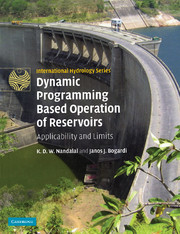Book contents
- Frontmatter
- Contents
- List of figures
- List of tables
- Preface
- 1 Water resources management
- 2 Incremental dynamic programming in optimal reservoir operation
- 3 Stochastic dynamic programming in optimal reservoir operation
- 4 Optimal reservoir operation for water quality
- 5 Large-scale reservoir system operation
- 6 Optimal reservoir operation for flood control
- References
- Index
6 - Optimal reservoir operation for flood control
Published online by Cambridge University Press: 14 August 2009
- Frontmatter
- Contents
- List of figures
- List of tables
- Preface
- 1 Water resources management
- 2 Incremental dynamic programming in optimal reservoir operation
- 3 Stochastic dynamic programming in optimal reservoir operation
- 4 Optimal reservoir operation for water quality
- 5 Large-scale reservoir system operation
- 6 Optimal reservoir operation for flood control
- References
- Index
Summary
Reservoir systems are operated in somewhat uncertain environments. The uncertainty is mainly due to forecasting of expected rainfall caused by events such as typhoons and resulting river inflows. The problem of optimizing real-time short-time on-line operation of complex reservoir systems under uncertainty is very difficult particularly during extreme events like floods or droughts. Practically no general solution is available for this type of problem. Thus, it is important to fully appreciate the problem of real-time reservoir operation under uncertainty before expedient methods for its solution can be developed. This section describes how far DP based operation can be used in the phase of short-term “emergency” operation or how far this type of short-term operation can be embedded in DP or SDP based rules.
Several operational modes can be employed for a water resources system. For example, in real-time on-line operation of a multipurpose reservoir, the importance of a purpose or particular demand may vary either periodically with the annual cycle or randomly due to the occurrence of floods. Real-time on-line operation may be defined as an interaction between the operator and the system while the operation is being executed, and the response time is critical within a definite time step. Consequently, real-time on-line operation may imply operational mode changes to respond to this critical situation. One of the most challenging decisions inherent in the operation of a reservoir is to decide when to change release policy and allocate storage space, for example for the purpose of flood control instead of for conservation storage, and vice versa.
Information
- Type
- Chapter
- Information
- Dynamic Programming Based Operation of ReservoirsApplicability and Limits, pp. 110 - 124Publisher: Cambridge University PressPrint publication year: 2007
